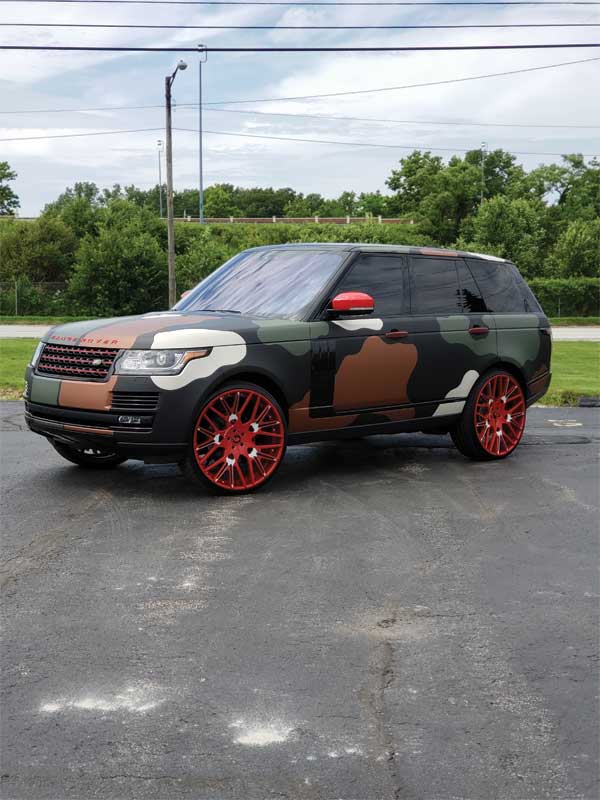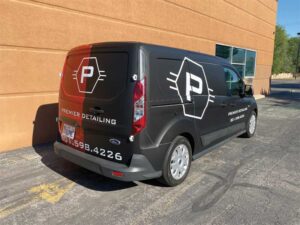Vehicle graphics: A market the industry has just started to tap
by all | 6 May 2021 10:34 pm
By Joey Heiob
 [1]
[1]The army fatigue/camouflage trend continues to be popular. To achieve this look, the vehicle was first wrapped with a matte black film, followed by colour pattern overlays using matte green, brown, and white wrapping films.
Like so many businesses, vehicle graphics printers and installers held their breath when the pandemic swept the globe a year ago. Would the fear, the quarantines and the lockdowns, the job losses, and the economic uncertainty combine to decimate the market? The answer, fortunately, is a resounding “no.” In fact, the sector proved resilient in the face of all these negative factors.
When the accounting for 2020 is complete, most vehicle graphics businesses will likely have notched a solid year, perhaps even set a record, and the overall industry will have stayed on the double-digit growth trajectory it has tracked over the last decade.
Defining the sector
Vehicle graphics is defined as the practice of applying a specially designed vinyl-wrapping film directly to the painted surface of a vehicle. The purpose is to change the colour or appearance of the vehicle for personal preferences or to display a commercial message. Vehicle graphics are an alternative to painting the body of a vehicle. Vinyl wraps have now largely displaced aftermarket vehicle repainting due to lower costs, faster turnaround, and the wide variety of options.
Vinyl wraps can last up to five years; and, they can be removed to return the vehicle to its original appearance. Graphics films are available as cast or calendered gloss white vinyl, which are digitally printed ‘canvases’ for custom designs and commercial branding. Vehicle colour change wrapping films come in a large variety of colours and textures, as well as different finishes, such as gloss, matte, metallic, and satin, that make it possible to achieve an endless variety of custom effects and graphic finishes.
Segmenting the market
The vehicle graphics market is most clearly divided into commercial and personal vehicle segments. In addition to automobiles, trucks and SUVs, the personal vehicle market also encompasses marine, RV, ATV, and off-road vehicles, while the commercial side includes food trucks, safety and emergency, and transit vehicles.
Commercial fleet graphics are an effective form of advertising and branding for businesses ranging from local plumbers or floral shops to the biggest brands and largest over-the-road truck fleets in the country. According to a study by the American Trucking Associations (ATA), a vehicle wrap on a typical trailer makes 10 million impressions every year[2]. Moreover, according another ATA study conducted by Robinson Yesawich & Pepperdine Inc., 97 per cent of individuals surveyed noticed the advertising on fleet vehicles and 98 per cent felt the ad portrayed a positive image of the advertiser. Further, 29 per cent of those surveyed said they would base a buying decision on those impressions.[3]
 [4]
[4]The ‘workhorse’ digital wrapping films, especially those with an opaque, high gloss property, are ideal for creating custom designs using digital print technology for vehicle graphics.
Vehicle wraps were adopted on the commercial side long before the consumer market emerged, so the commercial segment is much larger in terms of revenue and more mature in terms of future growth. It is also much more concentrated on the provider side—particularly at the heavy-duty vehicle level—compared to the fragmented personal vehicle segment. This is due to the longevity of the largest fleet graphics suppliers and the need for larger facilities, more sophisticated equipment, and more trained installers.
On the consumer side, straightforward colour change was the primary attraction when automobile vehicle wraps first appeared on the scene. It was not long before people started to realize it did not have to be a one-time thing—one could change the look of their car every couple of years, just because they felt like it.
Then, as film manufacturers introduced more dramatic products, and installers began to emphasize creativity over functionality, vehicle wrapping became about making a personal statement—not only for the vehicle owner, but also for the wrapper. It was also during this time when wrapping really took off at the high end of the market.
Growth opportunities
Today, there are growth opportunities in the vehicle graphics industry across the market spectrum. Although the commercial market is more mature and more concentrated, it continues to grow at a high single-digit rate. That said, smaller car wrap shops continue to expand into the van and box truck sub-sector, and new fleet customers are starting to see the value of well-executed rolling billboards.
On the personal vehicle side, the high end of the market has plenty of runway to grow, which can be attributed to social media, as the industry is just now starting to tap into the mainstream. While there are not too many everyday Ford Explorers or Toyota Camrys sporting a head-turning vinyl wrap, this is changing as the general public’s awareness of vehicle wraps continues to expand and existing customers move up to premium films.
 [5]
[5]Brand Graphic Solutions, a full-service print solutions company, helped their client, Mericle Commercial Real Estate Services, brand its fleet of company vans using digital wrapping film.
This author’s bullish view is echoed in the “Automotive Wrap Films Market Size, Share & Trends Analysis Report” by Grand View Research Inc., published in February 2020. It projects the global automotive wrap films market will expand at a compound annual growth rate of 22.5 per cent over the forecast period of 2020-22 to US$17.6 billion by 2027. The report cites the growing sign and graphics industry, low cost, and increasing demand for mobile advertising, combined with increasing trend of people wanting to personalize their cars. It notes the market has witnessed major advancements, both in terms of technology and material, to facilitate low cost and mass production of automotive wrap films. This leads to flexibility in design and ease of manufacturing for a range of applications involving all types of vehicles.
Keeping up with demand is a challenge in some regional markets. Shops report periodically having more business than they can handle. Fortunately, people work with each other in this industry. A shop may win a good-sized project, which might be more than they can handle in a short timeframe, and they will typically reach out to their network and say, “Hey, is anybody available? I need some help getting some installs done.” And people respond.
In the long-term, however, the industry needs to develop a steady stream of new wrapping talent if it is to keep up with this projected demand. In response to this, many vinyl-wrapping film manufacturers offer and support training programs, school partnerships, and other initiatives designed to attract new employees into the business; however, more needs to be done. Many smaller shops do not have the capacity to train potential wrappers on their own.
 [6]
[6]Justin Pate (pictured), an endorsed installer by The Wrap Institute, says this is the golden era for learning how to wrap cars because there are so many online instructional videos and hands-on workshops available.
However, Justin Pate, an endorsed installer by The Wrap Institute, which looks to help the vinyl wrap installation community reach higher standards of professionalism and efficiency, says, “This is the golden era for learning how to wrap a car because there are so many online instructional videos and hands-on workshops available. The Wrap Institute makes product videos for all the wrap film manufacturers, so the content directly aligns with how the specific film should be applied.
“That said, jobs are available, and there is a path for entrepreneurial types to move up the ladder—from employee to business owner. A trained and experienced wrapper can be up and running for $30,000 with a printer and a good laminator doing colour change wraps in their garage or a sublet space. We call it ‘a business in a box.’”
Selecting the right film
Vinyl wrap films from different manufacturers will have unique attributes, which may make one film easier to install or remove, more durable, or even more pleasing to the eye in terms of the colour or finish. After some trial and error, and industry word-of-mouth, most installers settle on a primary supplier whose films and digital overlaminates work best for them. Quick and easy installation is always an important consideration since labour (installation time) is roughly 90 per cent of the total cost.
As compared with colour change wrap films, the technical considerations are more extensive with fleet graphics, where one will be digitally printing on the film. That said, wrap shops should keep the following important film spec considerations in mind:
- Is a particular film compatible with one’s print and ink system?
- Will it let one print on all ink platforms: solvent, eco-solvent, ultraviolet (UV), and latex?
- Can the film accommodate different needs in terms of sizes: 1219, 1371, and 1524 mm (48, 54, and 60 in.)?
Some film suppliers have apps where one can download the right ink profile for their printer to ensure the highest print quality with the right amount of ink.
Workhorse and specialty films
As a versatile ‘workhorse,’ most wrappers will want a premium, high gloss, cast film with superior 3D conformability, excellent printability, and maximum durability for complex surfaces with curves and recesses. It should pair with a wide variety of digital overlaminates and work well for other standard applications (like walls) in addition to fleet graphics.
Wrappers should look for films with an adhesive that allows the material to not only slide easily across the surface, but also readily pulls apart if it folds on itself and allows installers to eliminate bubbles with a simple press of their finger.
In addition to this ‘workhorse’ film, one should also familiarize themselves with the more specialized films in a manufacturer’s line that may be better suited for certain surfaces. For example, these other films might include:
- A thicker film series best suited for flat to moderate curved installs like box trucks and trailers (with or without rivets), or car wraps but not for door handles and mirrors.
- A thinner film series suited for more contoured vehicles, or for semi-trailers with rivets and corrugations.
- An optically clear gloss film that can be used on window perforation, as well as on painted body surfaces.
- An extra conformable series designed for extreme compound curves such as on helmets and motorcycles, as well as deep recessed areas found on some commercial vans.
These specialized films may also give one the option of matte or satin finishes in addition to standard gloss.
 [7]
[7]Two-faced wraps remain popular for vehicle graphics due to the added visual impact when parked and on the road. Here, vehicle wraps and graphics shop Vinyl Wurx used satin black and Gloss red wrapping film to create the two-tone effect. The logo and vehicle lettering were completed using a gloss white film.
Do not forget the overlaminate
To enhance the way the colour pops, along with the durability of fleet graphics films, using them in combination with an overlaminate is always recommended. Most installers have a preferred all-purpose overlaminate but will also stock one or more specialty products.
The overlaminate protects against colour fade from the sun and UV light. Other options might include a laminate that is great for box trucks and trailers, and another that is super conformable and ideal if a shop is doing a lot of vans. As with the vinyl wrap films, most wrappers will want an overlaminate that installs quickly and easily with a minimum stress level.
Ensuring a satisfied customer
As successful business owners know, it is not always enough to do a great job. It is equally important not to overpromise and, yes, to overcommunicate. One should not assume the consumer knows what they need to do (or not do) after their purchase. The following are some basic guidelines one should share with their customers:
- Wash the wrapped vehicle on a regular basis;
- Use approved aftercare products for wraps;
- Avoid using waxes and cleaning products with alcohol—they can burn the lamination which will result in premature fading;
- Matte finishes require more care and maintenance than gloss finishes; and
- When it comes time to remove the film, it should always be done within the warranty period. When removing a wrap, the temperature of the substrate should be above 15.5 C
(60 F) for best results.
Lastly, wrappers should be sure to take full advantage of all the resources offered by their distributor, film manufacturer, and industry associations.
Joey Heiob is a technical service representative at Avery Dennison Graphic Solutions covering the eastern U.S. and Canada. He has 19 years of experience at the company, including the last 11 in technical service. For more information, visit graphics.averydennison.com[8].
- [Image]: https://www.signmedia.ca/wp-content/uploads/2021/05/ADGS_Image-1_2019-Range-Rover-Autobiography-Edition-Camo_@wrapohio.jpg
- According to a study by the American Trucking Associations (ATA), a vehicle wrap on a typical trailer makes 10 million impressions every year: https://www.truckinginfo.com/157526/importance-of-mobile-truck-van-marketing
- Further, 29 per cent of those surveyed said they would base a buying decision on those impressions.: https://www.truckinginfo.com/157526/importance-of-mobile-truck-van-marketing
- [Image]: https://www.signmedia.ca/wp-content/uploads/2021/05/Avery-Dennison_Image-3_MPI-1105-Mercedes.jpg
- [Image]: https://www.signmedia.ca/wp-content/uploads/2021/05/Avery-Dennison_Image-1_Mericle_Van_Wrap-17.jpg-.jpg
- [Image]: https://www.signmedia.ca/wp-content/uploads/2021/05/Avery-Dennison_Image-4_JustinPate-Wrap-Class-Image.jpg
- [Image]: https://www.signmedia.ca/wp-content/uploads/2021/05/Avery-Dennison_Image-2_Avery-Dennison-SWF-two-tone-van.jpg
- graphics.averydennison.com: https://graphics.averydennison.com/en/home.html
Source URL: https://www.signmedia.ca/vehicle-graphics-a-market-the-industry-has-just-started-to-tap/